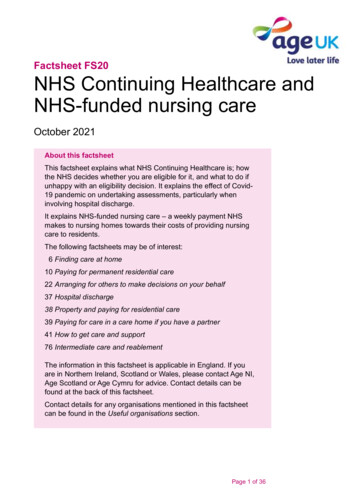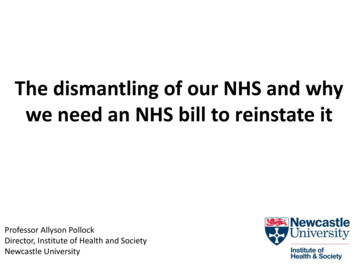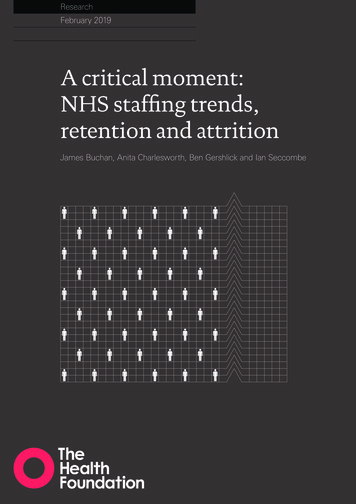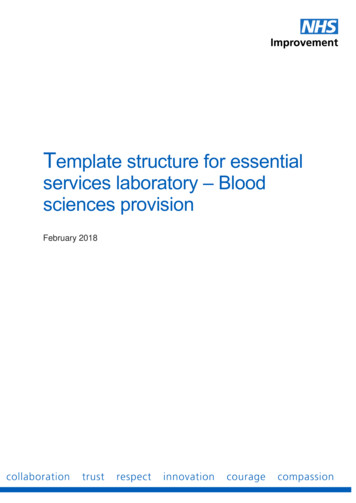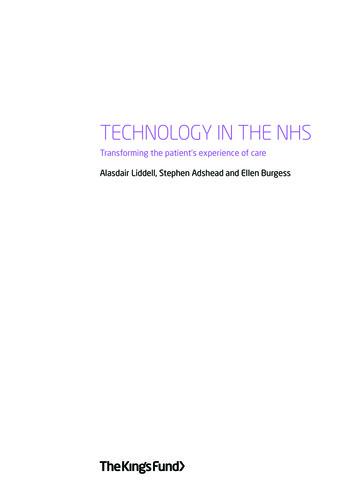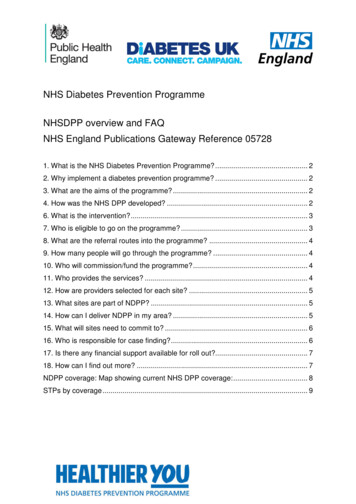
Transcription
Integrating careNext steps to building strong and effective integrated care systemsacross England
ContentsIntroduction . 2Purpose . 4Putting this into practice . 9Legislative proposals . 27Implications and next steps . 331 Contents
IntroductionThis document builds on previous publications that set out proposals for legislativereform and is primarily focused on the operational direction of travel. It opens up adiscussion with the NHS and its partners about how ICSs could be embedded inlegislation or guidance. Decisions on legislation will of course then be forGovernment and Parliament to make.This builds on the route map set out in the NHS Long Term Plan, for health andcare joined up locally around people’s needs. It signals a renewed ambition for howwe can support greater collaboration between partners in health and caresystems to help accelerate progress in meeting our most critical health and carechallenges.It details how systems and their constituent organisations will acceleratecollaborative ways of working in future, considering the key components of aneffective integrated care system (ICS) and reflecting what a range of local leadershave told us about their experiences during the past two years, including theimmediate and long-term challenges presented by the COVID-19 pandemic.These are significant new steps towards the ambition set out in the NHS Long TermPlan, building on the experience of the earliest ICSs and other areas. Our challengenow is to spread their experience to every part of England. From April 2021 this willrequire all parts of our health and care system to work together as Integrated CareSystems, involving: Stronger partnerships in local places between the NHS, localgovernment and others with a more central role for primary care inproviding joined-up care; Provider organisations being asked to step forward in formalcollaborative arrangements that allow them to operate at scale; and Developing strategic commissioning through systems with a focuson population health outcomes; The use of digital and data to drive system working, connect healthand care providers, improve outcomes and put the citizen at the heartof their own care.This document also describes options for giving ICSs a firmer footing in legislationlikely to take effect from April 2022 (subject to Parliamentary decision). Theseproposals sit alongside other recommendations aimed at removing legislativebarriers to integration across health bodies and with social care, to help deliverbetter care and outcomes for patients through collaboration, and to join up nationalleadership more formally. NHS England and NHS Improvement are inviting views2 Introduction
on these proposed options from all interested individuals and organisations byFriday 8 January 2021.It builds on, and should be read alongside, the commitments and ambitions set outin the NHS Long Term Plan (2019), Breaking Down Barriers to Better Health andCare (2019) and Designing ICSs in England (2019), and our recommendations toGovernment and Parliament for legislative change (2019).3 Introduction
1. Purpose1.1.The NHS belongs to us all1 and any changes to it must bring clearimprovements for our health and care. Since 2018, integrated care systems(ICSs) have begun doing just this, enabling NHS organisations, localcouncils, frontline professionals and others to join forces to plan and providearound residents’ needs as locally as possible.1.2.By doing this, they have driven a ‘bottom-up’ response to the big health andcare challenges that we and other countries across the world face and havemade a real difference to people’s lives. They have improved health,developed better and more seamless services and ensured public resourcesare used where they can have the greatest impact.1.3.These achievements have happened despite persistent complexity andfragmentation. This document describes how we will simplify support to localleaders in systems, making it easier for them to achieve their ambitions. Ourproposals are designed to serve four fundamental purposes: improving population health and healthcare; tackling unequal outcomes and access; enhancing productivity and value for money; and helping the NHS to support broader social and economicdevelopment.1.4.The NHS Long Term Plan set out a widely supported route map to tackle ourgreatest health challenges, from improving cancer care to transformingmental health, from giving young people a healthy start in life to closing thegaps in health inequalities in communities, and enabling people to look aftertheir own health and wellbeing.1.5.The COVID-19 pandemic has given the NHS and its partners their biggestchallenge of the past 70 years, shining a light on the most successfulapproaches to protecting health and treating disease. Vulnerable peopleneed support that is joined up across councils, NHS, care and voluntaryorganisations; all based on a common understanding of the risks differentpeople face. Similarly, no hospital could rise to the challenge alone, and newpathways have rapidly developed across multiple providers that enable andprotect capacity for urgent non-COVID care.1.6.This has all been backed up by mutual aid agreements, including with localcouncils, and shared learning to better understand effective response. It -nhs-constitution-for-england4 Purpose
required openness in data sharing, commitment to collaboration in theinterests of patients and communities, and agile collective decision-making.1.7.The significant challenges that face health and care as we recover from thepandemic make it even more important to have strong and thriving systemsfor the medium term. Important changes were driven by emergencyresponse but must be hard-wired into our future working so that the gains of2020 can endure. DHSC’s ‘Busting Bureaucracy: Empowering frontline staffby reducing excess bureaucracy in the health and care system in England’report, published on 24 November 2020, describes in detail some of theseimportant areas of change. The report found that there are many sources ofexcess bureaucracy and that these are often exacerbated by duplicative ordisproportionate assurance systems and poorly integrated systems at anational, regional and local level. The report also acknowledges that themore levels of hierarchy in a system, the more likely it is that bureaucracy willexist and grow. ICSs therefore have the potential to reduce bureaucracythrough increased collaboration, leaner oversight through streamlinedassurance structures and smarter data-sharing agreements.1.8.To deliver the core aims and purposes set out above, we will need to devolvemore functions and resources from national and regional levels to localsystems, to develop effective models for joined-up working at “place”, ensurewe are taking advantage of the transformative potential of digital and data,and to embed a central role for providers collaborating across biggerfootprints for better and more efficient outcomes. The aim is a progressivelydeepening relationship between the NHS and local authorities, including onhealth improvement and wellbeing.1.9.This reflects three important observations, building on the NHS Long TermPlan’s vision of health and care joined up locally around people’s needs: decisions taken closer to the communities they affect are likely tolead to better outcomes; collaboration between partners in a place across health, careservices, public health, and voluntary sector can overcome competingobjectives and separate funding flows to help address healthinequalities, improve outcomes, and deliver joined-up, efficientservices for people; and collaboration between providers (ambulance, hospital and mentalhealth) across larger geographic footprints is likely to be moreeffective than competition in sustaining high quality care, tacklingunequal access to services, and enhancing productivity.1.10. This takes forward what leaders from a range of systems have told us abouttheir experiences during the past two years.5 Purpose
Devolution of functions and resources1.11. Joining up delivery is not enough on its own. In many areas,we can shift national or regional resources and decisionmaking so that these are closer to the people they serve. For example, it willmake sense to plan, commission and organise certain specialised services atICS level, and to devolve a greater share of primary care funding andimprovement resource to this more local level.1.12. ICSs also need to be able to ensure collectively that they are addressing theright priorities for their residents and using their collective resources wisely.They will need to work together across partners to determine: distribution of financial resources to places and sectors that istargeted at areas of greatest need and tackling inequalities; improvement and transformation resource that can be usedflexibly to address system priorities; operational delivery arrangements that are based on collectiveaccountability between partners; workforce planning, commissioning and development to ensurethat our people and teams are supported and able to lead fulfilling andbalanced lives; emergency planning and response to join up action at times ofgreatest need; and the use of digital and data to drive system working and improvedoutcomes.“Place”: an important building block for health and careintegration1.13. For most people their day-to-day care and support needs will beexpressed and met locally in the place where they live. An important buildingblock for the future health and care system is therefore at ‘place.’1.14. For most areas, this will mean long-established local authority boundaries (atwhich joint strategic needs assessments and health and wellbeing strategiesare made). But the right size may vary for different areas, for examplereflecting where meaningful local communities exist and what makes senseto all partners. Within each place, services are joined up through primarycare networks (PCNs) integrating care in neighbourhoods.1.15. Our ambition is to create an offer to the local population of each place, toensure that in that place everyone is able to:6 Purpose
access clear advice on staying well; access a range of preventative services; access simple, joined-up care and treatment when they need it; access digital services (with non-digital alternatives) that put thecitizen at the heart of their own care; access proactive support to keep as well as possible, where they arevulnerable or at high risk; and to expect the NHS, through its employment, training, procurement andvolunteering activities, and as a major estate owner to play a full partin social and economic development and environmentalsustainability.1.16. This offer will be met through providers of primary care, community healthand mental health services, social care and support, community diagnosticsand urgent and emergency care working together with meaningful delegatedbudgets to join up services. It will also allow important links to be made toother public or voluntary services that have a big impact on residents’ day -today health, such as by improving local skills and employment or by ensuringhigh-quality housing.1.17. Delivery will be through NHS providers, local government, primary care andthe voluntary sector working together in each place in ICSs, built aroundprimary care networks (PCNs) in neighbourhoods.Developing provider collaboration at scale1.18. At some times, many people will have more complex or acuteneeds, requiring specialist expertise which can only be planned andorganised effectively over a larger area than ‘place’. This may be becauseconcentrating skills and resources in bigger sites improves quality or reduceswaiting times; because it is harder to predict what smaller populations willneed; or because scale working can make better use of public resources.1.19. Because of this, some services such as hospital, specialist mental health andambulance need to be organised through provider collaboration thatoperates at a whole-ICS footprint – or more widely where required.1.20. We want to create an offer that all people served by an ICS are able to:7 Purpose access a full range of high-quality acute hospital, mental health andambulance services; and experience fair access to these services, based on need and notfactors such as geography, race or socio-economic background.
1.21. We also need to harness the involvement, ownership and innovation ofclinicians, working together to design more integrated patient pathwayshorizontally across providers and vertically within local place-basedpartnerships.8 Purpose
2. Putting this into practice2.1.There are many good examples of recent system working that haveimproved outcomes and productivity, and helped to address inequalities. ButCOVID has made the case for a step up in scope and ambition. The NHSand local government are increasingly pressing for a more driven andcomprehensive roll-out of system working.2.2.So, in this section we set out a series of practical changes which will need tobe in place by April 2022 at the latest, to make a consistent transition tosystem working focused on further devolution to systems, greater partnershipworking at place and closer collaboration between providers on a largerfootprint. The main themes are:1. Provider collaboratives2. Place-based partnerships3. Clinical and professional leadership4. Governance and accountability5. Financial framework6. Data and digital7. Regulation and oversight8. How commissioning will change2.3.We will support preparatory work during 2021/22 with further guidance forsystems and in the NHS Operational Planning Guidance for 2021/22.Provider collaboratives2.4.Provider organisations will play an active and strong leadership role insystems. Through their mandated representation in ICS leadership anddecision-making, they will help to set system priorities and allocateresources.2.5.Providers will join up services across systems. Many of the challengesthat systems face cannot be solved by any one organisation, or by any oneprovider. Joining up the provision of services will happen in two main ways: within places (for example between primary, community, local acute,and social care, or within and between primary care networks)through place-based partnerships as described above (‘verticalintegration’); and9 Putting this into practice
between places at scale where similar types of provider organisationshare common goals such as reducing unwarranted variation,transforming services or providing mutual aid through a formalprovider collaborative arrangement (‘horizontal integration’ – forexample, through an alliance or a mental health providercollaborative).2.6.All NHS provider trusts will be expected to be part of a providercollaborative. These will vary in scale and scope, but all providers must beable to take on responsibility for acting in the interests of the populationserved by their respective system(s) by entering into one or more formalcollaboratives to work with their partners on specific functions.2.7.This greater co-ordination between providers at scale can support: higher quality and more sustainable services; reduction of unwarranted variation in clinical practice and outcomes; reduction of health inequalities, with fair and equal access acrosssites; better workforce planning; and more effective use of resources, including clinical support andcorporate services.2.8.For provider organisations operating across a large footprint or for thoseworking with smaller systems, they are likely to create providercollaboratives that span multiple systems to provide an effective scale tocarry out their role.2.9.For ambulance trusts specifically we would expect collaboration andintegration at the right scale to take place. This should operate at scale toplan resources and join up with specialist providers, and at a more local levelin places where focused on the delivery and redesign with other partners ofurgent and emergency care pathways.2.10. We want to spread and build on good work of this type already under way.The partnerships that support this collaboration (such as provider alliances)often take place on a different footprint to ICS boundaries. This shouldcontinue where clinically appropriate, with NHS England and NHSImprovement helping to ensure consistent and coherent approaches acrosssystems, especially for smaller partnerships.2.11. Local flexibility will be important but providers in every system, throughpartnership or any new collaborative arrangements, must be able to: deliver relevant programmes on behalf of all partners in the system;10 Putting this into practice
agree proposals developed by clinical and operational networks, andimplement resulting changes (such as implementing standardoperating procedures to support agreed practice; designating servicesto ensure their sustainability; or wider service reconfiguration); challenge and hold each other to account through agreed systems,processes and ways of working, e.g. an open-book approach tofinances/planning; enact mutual aid arrangements to enhance resilience, for example bycollectively managing waiting lists across the system.2.12. In some systems, larger providers may also choose to use their scale to hostfunctions on behalf of other system partners.2.13. NHS England and NHS Improvement will set out further guidance in early2021, describing a number of potential models for provider collaboratives,based on those that have been established in some parts of the country,including looser federations and more consolidated forms.2.14. We know that providers are already making progress towards effective,collaborative working arrangements despite the constraints of relevantlegislation and frameworks. Indeed, many crucial features of strong systemworking – such as trust between partners, good leadership and effectiveways of working – cannot be legislated for.But we recognise that these could be supported by changes to legislation,including the introduction of a ‘triple aim’ duty for all NHS providers to helpalign priorities, and the establishment of ICSs as statutory bodies with thecapacity to support population-based decision-making and to directresources to improve service provision. Our recommendations for this areset out in part 3.2.15. Systems will continue to play an increasingly important role in developingmultidisciplinary leadership and talent, coordinating approaches to recruiting,retaining and looking after staff, developing an agile workforce and makingbest use of individual staff skills, experience and contribution.2.16. From April 2022, this will include: developing and supporting a ‘one workforce’ strategy in line with theNHS People Plan and the People Promise, to improve the experienceof working in the NHS for everyone; contributing to a vibrant local labour market, with support from partnerorganisations and other major local employers, including the carehome sector and education and skills providers;11 Putting this into practice
enabling employees to have rewarding career pathways that span theentire system, by creating employment models, workforce sharingarrangements and passporting or accreditation systems that enabletheir workforce to be deployed at different sites and organisationsacross (and beyond) the system, and sharing practical tools tosupport agile and flexible working; valuing diversity and developing a workforce and leadership which isrepresentative of the population it serves; and supporting organisational and leadership development at all levels,including talent management. This should encompass investment in,and the development of, improvement expertise.Place-based partnerships2.17. In many places, there are already strong and effective place-basedpartnerships between sectors. Every area is different, but commoncharacteristics of the most successful are the full involvement of all partnerswho contribute to the place’s health and care; an important role for localcouncils (often through joint appointments or shared budgets); a leading rolefor clinical primary care leaders through primary care networks; and a clear,strategic relationship with health and wellbeing boards.2.18. The place leader on behalf of the NHS, as set out above, will work withpartners such as the local authority and voluntary sector in an inclusive,transparent and collaborative way. They will have four main roles: to support and develop primary care networks (PCNs) which join upprimary and community services across local neighbourhoods; to simplify, modernise and join up health and care (includingthrough technology and by joining up primary and secondary carewhere appropriate); to understand and identify – using population health managementtechniques and other intelligence – people and families at risk ofbeing left behind and to organise proactive support for them; and to coordinate the local contribution to health, social and economicdevelopment to prevent future risks to ill-health within differentpopulation groups.2.19. Systems should ensure that each place has appropriate resources,autonomy and decision-making capabilities to discharge these roleseffectively, within a clear but flexible accountability framework that enablescollaboration around funding and financial accountability, commissioning andrisk management. This could include places taking on delegated budgets.12 Putting this into practice
2.20. Partnerships within local places are important. Primary care networks inneighbourhoods and thriving community networks are also providercollaboratives, and for integration to be successful we will need primary careworking with community, mental health, the voluntary sector and social careas close to where people live as possible.2.21. The exact division of responsibilities between system and place should bebased on the principle of subsidiarity – with the system taking responsibilityonly for things where there is a clear need to work on a larger footprint, asagreed with local places.The NHS’s offer to local government2.22. We will work much more closely with local government and the voluntarysector at place, to ensure local priorities for improved health and careoutcomes are met by the NHS becoming a more effective partner in theplanning, design and delivery of care. This will ensure residents feel wellsupported, with their needs clearly understood; and with services designedand delivered in the most effective and efficient way for each place.2.23. As ICSs are established and evolve, this will create opportunities to furtherstrengthen partnership working between local government, the NHS, publichealth and social care. Where partnership working is truly embedded andmatured, the ability to accelerate place-based arrangements for localdecision-making and use of available resources, such as delegated functionsand funding, maximises the collective impact that can be achieved for thebenefit of residents and communities.Clinical and professional leadership2.24. Clinical and other frontline staff have led the way in working acrossprofessional and institutional boundaries, and they need to be supported tocontinue to play a significant leadership role through systems. ICSs shouldembed system-wide clinical and professional leadership through theirpartnership board and other governance arrangements, including primarycare network representation.2.25. Primary care clinical leadership takes place through critical leadershiproles including: Clinical directors, general practitioners and other clinicians andprofessionals in primary care networks (PCNs), who buildpartnerships in neighbourhoods spanning general practice,community and mental health care, social care, pharmacy, dentistry,optometry and the voluntary sector.13 Putting this into practice
Clinical leaders representing primary care in place-basedpartnerships that bring together the primary care provider leadershiprole in federations and group models. A primary care perspective at system level.2.26. Specialist clinical leadership across secondary and tertiary services mustalso be embedded in systems. Existing clinical networks at system,regional and national level have important roles advising on the mostappropriate models and standards of care, in particular making decisionsabout clinical pathways and clinically-led service change. System-wideclinical leadership at an ICS and provider collaborative footprint throughclinical networks should: be able to carry out clinical service strategy reviews on behalf of theICS; develop proposals and recommendations that can be discussed andagreed at wider decision-making forums; and include colleagues from different professional backgrounds and fromdifferent settings across primary care, acute, community and mentalhealth care.2.27. Wider clinical and professional leadership should also ensure a strongvoice for the wide range of skills and experience across systems. Fromnursing to social care, from allied health professionals to high street dentists,optometrists and pharmacists, and the full range of specialisms and caresettings, people should receive services designed and organised to reflectthe expertise of those who provide their care.Governance and public accountability2.28. Systems have told us from recent experience that good partnership workingmust be underpinned by mutually-agreed governance arrangements, clearcollective decision-making processes and transparent information-sharing.2.29. In the NHS Long Term Plan and NHS planning and contracting guidance for2020/21, we described a set of consistent operating arrangements that allsystems should put in place by 2021/22. These included: system-wide governance arrangements (including a systempartnership board with NHS, local councils and other partnersrepresented) to enable a collective model of responsibility anddecision-making; quality governance arrangements, notably a quality lead and qualitygroup in systems, focused on assurance, planning and improvement;14 Putting this into practice
a leadership model for the system, including an ICS leader withsufficient capacity and a chair appointed in line with NHSEI guidance;and agreed ways of working with respect to financial governance andcollaboration.2.30. ICSs now need to put in place firmer governance and decision-makingarrangements for 2021/22, to reflect their growing roles and responsibilities.With the below consistent framework, these should be flexible to match localneeds.2.31. As part of this, each system should define: ‘place’ leadership arrangements. These should consistently involve:i. every locally determined ‘place’ in the system operating apartnership with joined-up decision-making arrangements fordefined functions;ii. the partnership involving, at a minimum, primary care providerleadership, local authorities, including Director of Public Healthand providers of community and mental health services andHealthwatch;iii. agreed joint decision-making arrangements with localgovernment; andiv. representation on the ICS board.They may flexibly define:i. the configuration, size and boundaries of places which shouldreflect meaningful communities and scale for theresponsibilities of the place partnership;ii. additional membership of each place partnership that is likelyto include acute providers, ambulance trusts, the voluntarysector and other partners;iii. the precise governance and decision-making arrangementsthat exist within each place; andiv. their voting arrangements on the ICS board. provider collaborative leadership arrangements for providers ofmore specialist services in acute and mental health care. Theseshould consistently involve:i. every such provider in a system operating as part of one ormore agreed provider collaboratives with joined up decisionmaking arrangements for defined functions; andii. provider collaboratives represented on the appropriate ICSboard(s).15 Putting this into practice
They may flexibly define:i. the scale and scope of provider collaboratives. For smallersystems, provider collaboratives are likely to span multiplesystems and to be represented on the board of each. Thesearrangements should reflect a meaningful scale for theirresponsibilities;ii. the precise membership of each collaborative (acute providers,specialist providers, ambulance trusts at an appropriatefootprint, mental health providers);iii. the precise governance and decision-making arrangementsthat exist within each collaborative; andiv. their voting arrangements on the ICS board. individual organisation accountability within the system governanceframework. This will consistently involve:i. the responsibility and accountability of the individual providerorganisations for their current range of formal and statutoryresponsibilities (which are unchanged); andii. the accountability relationship between the providerorganisation and all place-based partnerships and providercollaboratives of which it is a member.It may flexibly define:iii. Any lead provider responsibility that the organisation holds onbehalf of a place partnership or a provider collaborative.2.32. Integrated care systems draw their strength from the effectiveness of theirconstituent parts. Their governance should seek to minimise levels ofdecision-making and should set out defined responsibilities of organisations,partnerships at place, provider collaboratives and the core ICS role. EachICS should seek to ensure that all the relevant bodies feel ownership an
Government and Parliament for legislative change (2019). 4 Purpose 1. Purpose 1.1. The NHS belongs to us all1 and any changes to it must bring clear improvements for our health and care. Since 2018, integrated care systems (ICSs) have begun doing just this, enabling NHS organisations, local



